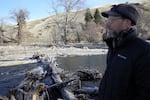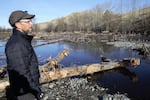
Ranch owner Ian Wilson illustrates the changes designed to make the Wallowa River a better habitat for spawning fish.
Kristian Foden-Vencil / OPB
One of Ian Wilson’s greatest joys is going down to the short stretch of the Wallowa River on his family’s ranch to fly fish.
“For me, it’s the equivalent of … church for someone who is deeply religious,” he said.
But as a fish biologist, he’s also long known there was something off about the river as it cut across his property: The Wallowa was oddly, unnaturally straight. And because of that, it wasn’t very hospitable for fish. Rather than stop and spawn, salmon and steelhead tended to swim through the property.
Salmon like clean, shallow gravel beds to lay eggs. And smolt, or baby salmon, prefer lots of little still-water pools where they can relax and fatten up on insects. Basically, they need the kind of meandering river system that naturally occurs in a floodplain.
Over the years, Oregon’s farmers, road builders and developers cleared many of the state’s floodplains by cutting trees and filling in channels. Doing so maximized their ability to use land.
For farmers, clearing and filling land creates new productive fields for crops and grazing, increasing food production and profits. The practice was a significant boon to Oregon’s agricultural industry — and to consumers.
But now, because Chinook, steelhead and trout are listed under the Endangered Species Act, the Bonneville Power Administration is trying to rebuild floodplains using revenue from electricity generation.
With help from the nonprofit Trout Unlimited, Wilson won a $1.2 million BPA grant to restore his three-quarter mile stretch of river.

Restoration crews worked to restore the Wallowa River back to its wilder, earlier state along rancher Ian Wilson's property.
Kristian Foden-Vencil / OPB
In the summer of 2022, crews placed 475 trees, many complete with massive root wads, in the channel to slow water down and spread it out. They built 54 artificial beaver dams to hold water in the floodplain and create lots of little stillwater pools. And they planted cottonwood, willow and alder trees for shade.
Considering the aim was to restore the river to a more natural state, the restoration was a relatively industrial project, with excavators and dump trucks. They dug channels and filled-in deep river pools.
Wilson said the work vastly increased fish spawning habitat. It used to take him 45 minutes to look for salmon eggs in the river, “Now it takes me upwards of half a day, because there’s so much water to walk,” he said. “Same flows, but there’s just so much more area to cover.”
The restoration finished in September and lots of new animals have already shown up. Where Wilson used to see 10 ducks, he said there are maybe 100 now. He’s also spotted bald eagles, dragonflies and songbirds.
“Within two months, we had beavers return, which was beyond my wildest expectations,” Wilson said. “We’ve seen a black bear recently. We just saw a bobcat this last Sunday and there’s a lot of coyotes out.”

Rancher Ian Wilson and his dog Buddy regularly walk the newly restored floodplain looking for wildlife,
Kristian Foden-Vencil / OPB
It’s an environmentalist’s dream. But this is eastern Oregon, where endangered species listings have hurt local economies in the eyes and experiences of some residents. Land used for chinook salmon, the gray wolf, the Oregon spotted frog and other animals cannot easily be used for logging, mining or grazing, limiting economic activity.
And unlike many of his neighbors, Wilson is not reliant on his ranch income because he and his wife have other jobs. So he said when he gets the odd sour look at the grocery store he understands why, ”You know people give me a hard time,” he said. “And you just have to kind of accept that I guess, to some level.”
But Wilson points out, watershed restoration efforts do help the local economy by providing work and buying trees.
Dissent peaked when the work was at its busiest. All the trees were staged along the road next to Wilson’s house, in preparation for putting them in the river.
Neighbor Ken Hohman called Wilson with questions. He said it looked more like a logging yard than a restoration project.
“Yeah, there were several piles of logs. I guess they were up to 30 feet high,” he said
And they were all hauled along a dirt road, right past his home.
“There was dust in the air, every day for a while,” Hohman said.

Ken and Janet Hohman didn't know anything about the river restoration project until hundreds of trees started being off-loaded at Ian Wilson's ranch.
Kristian Foden-Vencil / OPB
Wilson had warned adjacent neighbors about the work. But Hohman lives a couple of miles away and didn’t know what was going on. He worried all those trees might get washed downstream, clog the bridges and create a flood.
“I began to wonder if it was designed in such a way that those logs were going to stay there, rather than come down river during a high flow,” Hohman said.
In hindsight, Wilson thinks he could have contacted more neighbors, even though it’s not required, “That probably would have gone a long way towards maybe a little more understanding, initially.”
To try to calm the waters, after all the work was finished Wilson held a neighborhood barbecue, to show everyone what he was up to.
“My reaction was, it was a huge project,” said Janet Hohman, Ken’s wife. She’s happy to see new riparian areas being created, but she’s withholding her verdict until it’s clear no logs get flushed downriver.
But Ken Hohman said he felt better after seeing all the work.
“I mean, it’s a good project,” he said. " I wouldn’t spend $1 million of my money on it, but yeah.”
The money came from the BPA, which funds hundreds of projects to protect endangered salmon every year. In addition to habitat restoration, the money is spent to remove dams and improve fish ladders.

Rancher Ian Wilson shows how 54 artificial beaver dams help slow water as it flows across the restored floodplain, creating habitat for juvenile salmon.
Kristian Foden-Vencil / OPB





